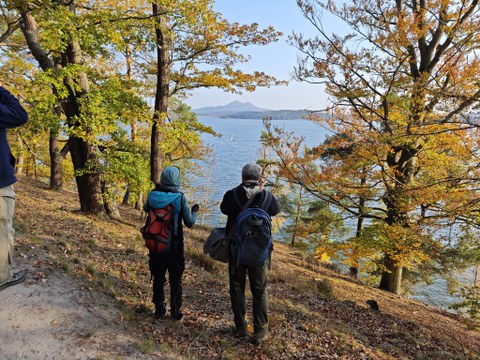Dec 09, 2024
FENIX Field Excursion in Staré Splavy – A Field Report
There is a pleasant freshness when you enter the station forecourt in Zittau at the end of October. An hour and a half away from Dresden, you finally leave the oppressive confines of the city, something you really don't have to fear in the state capital. The small town on the edge of Saxony, interspersed with bell towers, is almost cramped in the Upper Lusatian corner and is sheltered by national borders on all sides. This is fortunate, because we want to cross the Czech border to get to today's excursion as part of the FENIX project.
We change from train to car. We head south via Lückendorf (DE) and Petrovice (CZ) to the Ralsko Geopark in the Liberec region. Through the Zittau Mountains, past millions and millions of autumn leaves in every imaginable color, the weather presents us with a particularly pleasant sunshine. Arriving in Staré Splavy, we encounter one natural highlight after another. Besides us two students, the participants from Germany are the TU Dresden, the IHI Zittau and the Senckenberg Museum Görlitz. Czech participants are at least the TU Liberec and numerous teachers.
It starts with a thematic input from the Liberec geography didactics department in an old half-timbered house, the low door frame of which I can't help but hit my head hard once. However, our tasks in the field are not long in coming. Today's task is to develop a map - divided into two groups. Group one is to draw in colors on a map of the place what feelings they associate with the respective specific buildings etc., whether something is missing or something they particularly like. The second group is given a blank sheet of paper and asked to draw a “mental map”. The results from group two are very divergent, because the Czech teachers assume that they will deliver a drawing that is as cartographically correct as possible, while my German companions and I don't miss the opportunity to take a leisurely stroll through the village and then draw the most impressive features in a reasonably orderly fashion. In the end, it has to be said that both approaches can firstly be wonderfully embedded in geography lessons and secondly are an exciting activity in the field.
The rest of the day will be about research-oriented teaching. We split up into groups again and a little later I find myself on the shore of the reservoir, speculating about its formation with a focus on geomorphological features in connection with historical facts. As a student teacher for these subjects, it was a particularly exciting and enriching experience! A collection of maps, information and illustrations about the lake and its geological features were provided. In combination with historical background knowledge and our own reflections, we were able to understand why a reservoir was built so successfully at this location in the Czech Republic in the late Middle Ages.
The rest of the day consisted of a hike paired with lots of interactive tasks in the forest around Staré Splavy, so that we weren't asked to think much more as the sun set and the autumn chill set in. All in all, a well-rounded stay with lots of different didactic suggestions - especially for spending time outside with your own pupils.
Jonathan Franz
FENIX is a joint project of the TU Liberec, the TU Dresden, the IHI Zittau of the TU Dresden, the Geopark Ralsko, the North Bohemian Museum Liberec and the Senckenberg Museum Görlitz. The aim of the project is to design materials and methods for a joint cross-border research field education of primary and secondary school teachers, tourist guides, nature conservationists and museum experts focusing on geography, geology, ecology and landscape education in the border region of the Czech Republic and Saxony. FENIX is co-financed by the European Union within the framework of Interreg SN - CZ.
Further excursion impressions:



